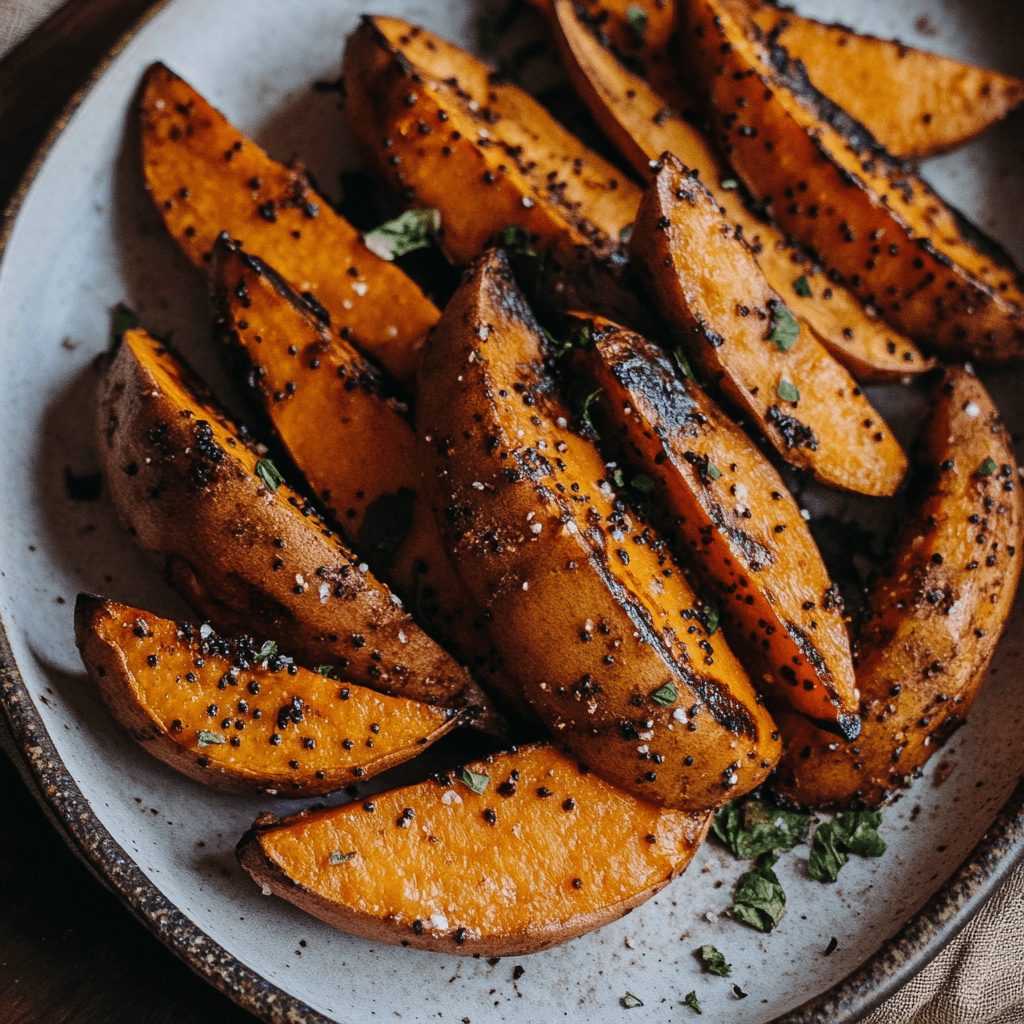Sweet potatoes are starchy, sweet-tasting root vegetables that are a staple in many cuisines worldwide. While they are beloved for their versatility and vibrant flavors, many people encounter black spots on sweet potatoes and wonder about their safety and causes. This article explores everything you need to know about these spots, from their origins to tips for prevention and safe consumption.
Table of Contents
Nutritional Value of Sweet Potatoes
Sweet potatoes are not only delicious but also highly nutritious. They are rich in:
- Vitamins: Particularly high in vitamin A (as beta-carotene), vitamin C, and vitamin B6.
- Minerals: A good source of potassium, manganese, and magnesium.
- Fiber: Beneficial for digestion and gut health.
- Antioxidants: Help combat free radicals and reduce inflammation.
With their low glycemic index, sweet potatoes are an excellent option for those managing blood sugar levels, providing sustained energy and satiety.
Identifying Black Spots on Sweet Potatoes
Causes of Black Spots on Sweet Potatoes
Black spots on sweet potatoes can occur for several reasons:
- Physical Damage: Bruising during harvesting, transport, or storage can lead to darkened areas.
- Fungal or Bacterial Infection: Certain pathogens can cause discoloration, resulting in black spots.
- Internal Browning: Prolonged storage or exposure to low temperatures can cause natural stress reactions in the tuber.
While these spots are not always a sign of spoilage, understanding their causes is essential to assess whether the sweet potato is safe to consume.
Are Black Spots Dangerous?
For more information on safe consumption, visit our article on sweet potato spoilage tips.
How to Safely Prepare Sweet Potatoes with Black Spots
When sweet potatoes develop black spots, you can:
- Inspect Thoroughly: Ensure there are no additional signs of decay.
- Cut Away Affected Areas: Use a knife to remove discolored parts.
- Use the Rest: The unaffected portions can be cooked and eaten.
For storage tips that prevent spoilage, read how to keep sweet potatoes fresh.
Prevention of Black Spots
- Proper Storage: Ensure a cool, dry, and ventilated area.
- Handle with Care: Avoid rough handling during transport and storage.
For additional guidance, explore the benefits of sweet potatoes and how they contribute to your health in sweet potatoes benefits.
Difference Between Normal and Rotten Black Spots
- Normal Black Spots: These are often superficial and caused by minor handling stress or bruising. Such spots can be easily trimmed, leaving the rest of the sweet potato perfectly safe to consume.
- Rotten Black Spots: Indicated by mushy texture, foul odor, or mold growth. These signs suggest spoilage, and the sweet potato should be discarded to prevent foodborne illnesses.
For detailed guidance on how to identify signs of spoilage in sweet potatoes, check out sweet potato spoilage tips.

Are Black Spots on Sweet Potatoes Dangerous?
Can Eating Sweet Potatoes with Black Spots Be Harmful?
In most cases, black spots are not harmful if they are dry, superficial, and caused by handling or minor stress. However, careful inspection is necessary to determine safety:
- Safe to Eat: Firm sweet potatoes with small, dry spots can be salvaged by removing the discolored areas.
- Avoid Consumption: If the sweet potato has a mushy texture, a foul smell, or extensive discoloration, it should be discarded.
Learn more about safe practices for extending the shelf life of sweet potatoes in our guide on how to keep sweet potatoes fresh.
How to Handle Sweet Potatoes with Black Spots
When preparing sweet potatoes with black spots, follow these steps:
- Inspect Thoroughly: Check for other signs of decay or spoilage.
- Trim the Affected Areas: Remove black spots and any surrounding discoloration.
- Cook the Remaining Parts: The unaffected sections can be safely used in recipes like soups, stews, or roasts.
Risks of Consuming Rotten or Moldy Sweet Potatoes
Eating rotten or moldy sweet potatoes can pose health risks, such as:
- Food Poisoning: Consuming decayed areas can lead to gastrointestinal issues like nausea, vomiting, or diarrhea.
- Toxins from Mold: Some molds produce mycotoxins, which can be harmful to health and may cause allergic reactions or, in severe cases, serious illness.
To avoid these risks, discard any sweet potatoes that show signs of mold, excessive softening, or a foul smell.
Factors that Lead to Black Spots
Impact of Storage Conditions on Sweet Potatoes
Improper storage is a common reason why sweet potatoes develop dark spots or discoloration. Factors include:
- Temperature: Exposure to low temperatures (below 55°F/13°C) can cause internal browning and stress-related dark areas.
- Humidity: High humidity may encourage fungal or bacterial growth, resulting in visible discoloration.
- Physical Stress: Rough handling or pressure during storage can lead to bruising that darkens over time.
Storing sweet potatoes in a cool, dry, and well-ventilated area is key to avoiding such issues.
How Age and Harvesting Practices Affect Sweet Potatoes
- Natural Aging: Over time, sweet potatoes begin to degrade, making them more prone to internal browning and darkened spots.
- Harvesting Techniques: Improper methods, such as excessive pulling or cutting, can cause damage that later manifests as spots during storage.
How to Safely Eat Sweet Potatoes with Discolored Areas
Can You Cut Off Discolored Areas and Eat the Rest?
Yes, you can safely consume sweet potatoes with minor discolorations, provided the affected areas are superficial and unaccompanied by signs of spoilage like mold or foul odors. To ensure safety:
- Inspect Thoroughly: Examine for additional signs of decay.
- Trim Affected Parts: Use a knife to cut away the discolored areas and any surrounding damage.
- Use the Good Portions: The rest of the sweet potato can be safely cooked and eaten.
If the sweet potato shows extensive damage or emits a strong odor, it’s best to discard it.discard it.
Best Ways to Prepare Sweet Potatoes with Minor Discolorations
When dealing with sweet potatoes that have a few spots, certain cooking methods help make the most of the unaffected parts:
- Baking or Roasting: Trim the discolored areas, then slice or cube the rest. Baking or roasting enhances their natural sweetness.
- Mashing: After removing the spots, cook and mash the sweet potatoes. Any slight discoloration after trimming is less noticeable when mashed.
- Soup or Stew: Add trimmed sweet potatoes to soups or stews where small imperfections won’t affect the overall dish.
Ways to Prevent Black Spots on Sweet Potatoes
Proper Storage Techniques
To reduce the occurrence of black spots, store sweet potatoes under ideal conditions:
- Temperature: Keep them in a cool, dry place, ideally between 55–60°F (13–16°C). Avoid refrigeration, as it causes internal stress.
- Ventilation: Store in a well-ventilated container, such as a mesh bag or basket, to prevent moisture buildup.
- Avoid Rough Handling: Handle sweet potatoes gently to minimize bruising during storage.
Handling and Cooking Tips for Fresher Sweet Potatoes
- Use Fresh Sweet Potatoes: Aim to use them within a few weeks of purchase to avoid age-related black spots.
- Check Before Cooking: Inspect each sweet potato for black spots or signs of spoilage before preparation.
- Gentle Washing: Clean sweet potatoes with a soft brush under running water to remove dirt without causing skin damage.
- Cooking Quickly: Cook sweet potatoes soon after peeling to prevent oxidation and discoloration.
What Experts Say About Black Spots on Sweet Potatoes
Advice from Nutritionists and Food Safety Experts
Experts agree that black spots on sweet potatoes are not always a cause for concern. These spots often result from physical damage, storage conditions, or natural aging, and they do not necessarily mean the sweet potato is unsafe to eat. Here’s what the experts recommend:
- Nutritionists: Black spots do not significantly affect the nutritional value of the unaffected parts of the sweet potato.
- Food Safety Experts: Advise cutting away the discolored areas as long as the rest of the flesh is firm and free from mold or foul odor.
- General Guidance: When in doubt about a sweet potato’s safety, err on the side of caution and discard it.
For more insights into maximizing the freshness and safety of sweet potatoes, see how to keep sweet potatoes fresh.
How Black Spots Relate to the Health of Sweet Potatoes
Black spots can indicate stress or physical damage, but they are not always a sign of spoilage. It’s important to distinguish between the two types:
- Superficial Spots: Common and harmless, caused by handling or minor pressure during transport or storage. These can be trimmed away.
- Extensive or Deep Spots: May indicate spoilage or fungal infection, particularly if the sweet potato has a soft texture or unpleasant odor.
For tips on spotting and preventing spoilage, check out sweet potato spoilage tips.
What to Do with Sweet Potatoes That Have Black Spots
If the sweet potato appears mostly unaffected:
- Inspect for Signs of Decay: Ensure there is no mold or unusual smell.
- Cut Away the Spots: Remove any blackened areas carefully.
- Use the Rest: The unaffected portions can be used in recipes or stored safely.
To explore more about the nutritional and culinary benefits of sweet potatoes, visit sweet potatoes benefits.
How to Tell if Sweet Potatoes are Bad Beyond Black Spots
Signs of Spoiled Sweet Potatoes
Beyond black spots, there are other clear indicators of spoilage in sweet potatoes:
- Soft or Mushy Texture: A firm sweet potato is a good sign of freshness; mushiness suggests spoilage.
- Foul Odor: A strong, unpleasant smell indicates decay.
- Mold or Mildew: Visible growth of mold, especially in crevices or around black spots, makes the sweet potato unsafe to eat.
- Excessive Wrinkling or Shriveling: A sign that the sweet potato has lost too much moisture and may no longer be fresh.
When to Discard Sweet Potatoes with Visible Signs of Decay
You should discard sweet potatoes if:
- They have extensive mold or fungal growth that cannot be trimmed away.
- The flesh is soft, slimy, or exudes liquid.
- There is a pervasive bad smell, even after cutting away black spots.
- They show signs of severe dehydration, such as excessive shriveling or hollowing inside.
Conclusion: Should You Eat Sweet Potatoes with Black Spots?
Final Verdict on Eating Sweet Potatoes with Black Spots
Sweet potatoes with black spots are often safe to eat if the spots are minor, superficial, and unaccompanied by other signs of spoilage. Here’s the final takeaway:
- Safe to Eat: If the sweet potato is firm, and the black spots are caused by minor bruising or stress, simply trim the spots and use the rest.
- Avoid Consumption: Discard the sweet potato if it has signs of spoilage such as mushy texture, foul odor, mold, or extensive discoloration.


